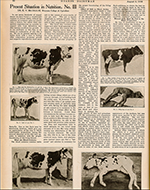 In present day ration balancing, vitamin requirements have become an integral portion of any software program. We know that a lack of vitamin E in calves stunts development and leads to white muscle disease. But at the turn of the 20th century, vitamins were a novel concept.
In present day ration balancing, vitamin requirements have become an integral portion of any software program. We know that a lack of vitamin E in calves stunts development and leads to white muscle disease. But at the turn of the 20th century, vitamins were a novel concept. Up to this point, most agricultural scientists believed that the optimal diet consisted of an appropriate balance of carbohydrates, proteins and fats. Yet, farmers disagreed – some cows fed on supposedly balanced diets thrived, while others fell ill or failed to reproduce.
Through a four-part series that began running in the June 21, 1916, issue of Hoard's Dairyman, Dr. E.V. McCollum first reported the discovery of vitamins. In his first installment he addressed concerns regarding growth on seemingly balanced diets:
"We fed four lots of young heifers . . . rations containing the same content of protein and digestible nutrients, but one ration was made up wholly from the wheat plant, another from the corn plant, and another from the oat plant. A fourth lot received a ration made up of a mixture derived from all three plants."
He continued, "After a few months it became easily observable that the wheat lot was not so well nourished as the others. The corn and oat fed lots bred earlier than the wheat fed one. The corn lot produced calves that were of normal size and full of vigor. The oat lot produced calves which were of about normal size but with very low vigor, while those from the wheat lot were about half as large as the normal calf at birth and were dead or ready to die when born."
This group of University of Wisconsin researchers found that when milk, butter or egg yolks were added to the inadequate diets, cows were healthier. McCollum extracted the fats, the lipid-soluble fraction, from the water. As we know now, some vitamins dissolve well in water while others dissolve in fat.
McCollum coined the lipid-soluble part "A" and the water-soluble portion "B." These names remain with us today.
In his article, "Present Situation in Nutrition, No. II," McCollum makes his first reference to the term vitamine, coined by Casimir Funk, noting that such a term may be inappropriate to denote the unknown substance they have found. He instead referred to them as water-soluble and fat-soluble unknowns.
"Those who have studied the cause and treatment of beri-beri learned several years ago that something in rice polishings would prevent the onset of the disease and Funk gave the name vitamine to the substance. Our studies show that in beri-beri the water soluble unknown only was involved for it is this that the animal runs out of first.
"There are good reasons why vitamine is not a good name to designate collectively the two dietary essentials we are considering, but since they are of a technical nature and concern only the chemists, they need not be considered here. We have proposed to call them the fat soluble A and the water soluble B," McCollum continued.
McCollum went on to note areas in need of further exploration, "To what extent have the unknown fat soluble A and water soluble B, which make the difference between failure and success, been inactivated or removed by these processes and the chemical treatment frequently given to prevent fermentation during the time when the materials are in a moist condition."
These long ago studies in cattle and swine allowed for significant strides to be made in human nutrition as well, paying dividends well beyond the farm gate. To read one of McCollum's early articles, click here.

The author is an associate editor and an animal science graduate of Cornell University. Smith covers feeding, milk quality and heads up the World Dairy Expo Supplement. She grew up on a Medina, N.Y., dairy, and interned at a 1,700-cow western New York dairy, a large New York calf and heifer farm, and studied in New Zealand for one semester.









